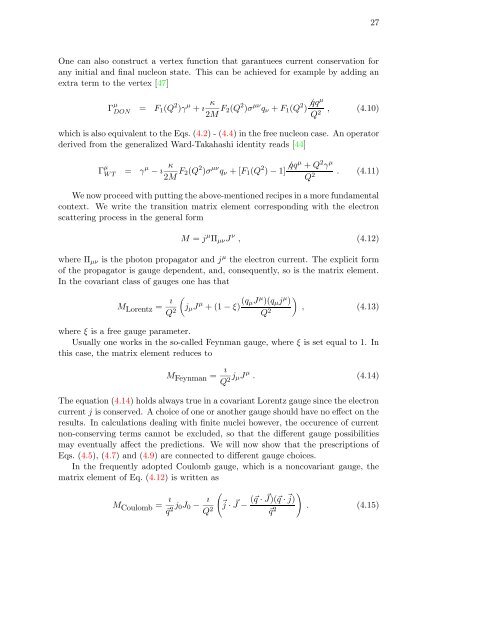Download Thesis in Pdf Format - Theoretical Nuclear Physics and ...
Download Thesis in Pdf Format - Theoretical Nuclear Physics and ...
Download Thesis in Pdf Format - Theoretical Nuclear Physics and ...
Create successful ePaper yourself
Turn your PDF publications into a flip-book with our unique Google optimized e-Paper software.
27<br />
One can also construct a vertex function that garantuees current conservation for<br />
any <strong>in</strong>itial <strong>and</strong> f<strong>in</strong>al nucleon state. This can be achieved for example by add<strong>in</strong>g an<br />
extra term to the vertex [47]<br />
Γ µ DON = F 1(Q 2 )γ µ + ı κ<br />
2M F 2(Q 2 )σ µν q ν + F 1 (Q 2 )̸ qqµ<br />
Q 2 , (4.10)<br />
which is also equivalent to the Eqs. (4.2) - (4.4) <strong>in</strong> the free nucleon case. An operator<br />
derived from the generalized Ward-Takahashi identity reads [44]<br />
Γ µ W T<br />
= γ µ − ı κ<br />
2M F 2(Q 2 )σ µν q ν + [F 1 (Q 2 ) − 1]̸ qqµ + Q 2 γ µ<br />
Q 2 . (4.11)<br />
We now proceed with putt<strong>in</strong>g the above-mentioned recipes <strong>in</strong> a more fundamental<br />
context. We write the transition matrix element correspond<strong>in</strong>g with the electron<br />
scatter<strong>in</strong>g process <strong>in</strong> the general form<br />
M = j µ Π µν J ν , (4.12)<br />
where Π µν is the photon propagator <strong>and</strong> j µ the electron current. The explicit form<br />
of the propagator is gauge dependent, <strong>and</strong>, consequently, so is the matrix element.<br />
In the covariant class of gauges one has that<br />
M Lorentz =<br />
ı (<br />
Q 2 j µ J µ + (1 − ξ) (q µJ µ )(q µ j µ )<br />
)<br />
Q 2<br />
, (4.13)<br />
where ξ is a free gauge parameter.<br />
Usually one works <strong>in</strong> the so-called Feynman gauge, where ξ is set equal to 1. In<br />
this case, the matrix element reduces to<br />
M Feynman =<br />
ı<br />
Q 2 j µJ µ . (4.14)<br />
The equation (4.14) holds always true <strong>in</strong> a covariant Lorentz gauge s<strong>in</strong>ce the electron<br />
current j is conserved. A choice of one or another gauge should have no effect on the<br />
results. In calculations deal<strong>in</strong>g with f<strong>in</strong>ite nuclei however, the occurence of current<br />
non-conserv<strong>in</strong>g terms cannot be excluded, so that the different gauge possibilities<br />
may eventually affect the predictions. We will now show that the prescriptions of<br />
Eqs. (4.5), (4.7) <strong>and</strong> (4.9) are connected to different gauge choices.<br />
In the frequently adopted Coulomb gauge, which is a noncovariant gauge, the<br />
matrix element of Eq. (4.12) is written as<br />
M Coulomb = ı<br />
⃗q 2 j 0J 0 −<br />
ı<br />
(<br />
⃗j<br />
Q 2 · ⃗J − (⃗q · ⃗J)(⃗q<br />
)<br />
· ⃗j)<br />
⃗q 2 . (4.15)















